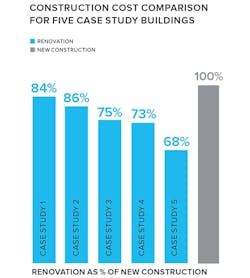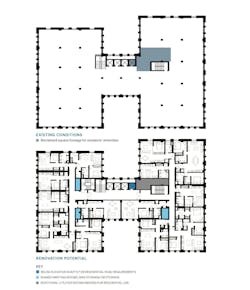Emptied-out office buildings probably won’t fill up any time soon, as the remote-work trend looks to outlast the pandemic, according to news reports and research. At the same time, the nation’s housing shortage has gone from bad to worse, with over 5 million homes now needed to meet demand, according to research from Realtor.com.
But both challenges could be addressed by converting offices into housing, according to a recent research report by BAR Architects, an architectural, interior design, and planning firm based in San Francisco. It’s an option that cities across the country, faced with unused or underused office buildings, have been considering.
In its report, BAR Architects analyzed five California office buildings, dating from the early 1900s through the 1970s, as sites for hypothetical office-to-housing conversions: two each in Los Angeles and San Francisco and one in San Jose. Along with collaborators Holmes Structures, Holmes Fire, Interface Engineering, TBD Consultants, and Plant Construction, BAR Architects explored the potential opportunities and challenges involved in such conversions.
BENEFITS OF OFFICE-TO-HOUSING CONVERSION
The report found that office-to-housing conversions could deliver a host of benefits—including cost. Such renovations could save up to 30% of the cost for new construction. Not surprisingly, however, there are more savings to be found in converting a newer office building than an older one. That’s primarily because newer structures require fewer modifications to their structural systems and exterior envelopes. With older buildings that need upgrades to their structures and envelopes, the savings could fall to 15%.
For example, converting a 24-story office tower built in 1971 into a 180-unit residential building would come to 68% of the cost of building an equivalent new structure. Yet converting a 16-story office building from 1921 into a 325-unit residential building would cost 86% of building it new. Still cheaper than new construction—just not as cheap.
But cost isn’t the only issue. “There’s both a financial reason to convert office to housing and a societal and urban benefit,” says Zach Prowda, Associate Principal, BAR Architects.
Reusing buildings conserves resources, offsetting the environmental impact of demolition and new construction. “Converting or upgrading buildings that already exist is the most sustainable thing you can do,” Prowda says.
Conversions also can be simpler in some ways than building new. It’s often less difficult to get approvals to renovate existing structures than to create new ones. California, for instance, where the median home price has surpassed $800,000, suffers from what Prowda calls the duality of “how much housing we need and how hard we make building housing.” But Los Angeles has an adaptive reuse ordinance that could expedite the entitlement process for office-to-residence conversions.
“We see a lot of opportunities in converting office to residential for existing owners who either have an underperforming asset or are interested in developing it to maximize profits or diversify,” Prowda says.
Residents could benefit as well. Downtown office buildings offer a great potential for sustainable residential living because they’re already integrated with the city and its infrastructure, they’re within walking distance to shops and offices, and they’re close to plenty of travel options. Urban neighborhoods that have a variety of buildings—office, housing, retail, and entertainment—make for healthier and more vibrant communities, Prowda notes.
Older office buildings also can provide architectural and aesthetic advantages, the report finds. Compared to new apartment buildings, older structures often have more distinctive characters—not to mention taller ceilings.
“We know the need is there, and we know how difficult it is to build,” Prowda says of the housing shortage. “To get housing built in a sustainable, healthy, beautiful way quicker and cheaper, there are all sorts of tools that architects and developers look at. And we believe office-to-housing conversions should be one of them.”
To get access to the report in its entirety, click the button below.


